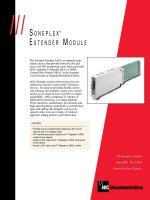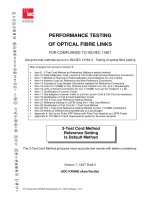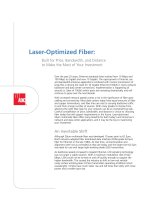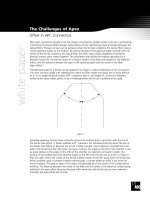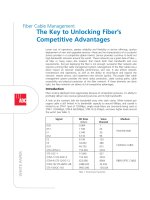Tài liệu TCP/IP Quick Guide pdf
Bạn đang xem bản rút gọn của tài liệu. Xem và tải ngay bản đầy đủ của tài liệu tại đây (609.19 KB, 4 trang )
TCP/IP Quick Guide
Layer 7: Application Layer
Defines interface to user processes
Provides standardized network services
Layer 6: Presentation Layer
Specifies architecture-independent data
transfer format
Encodes and decodes data;
Encrypts and decrypts data;
Compresses and decompresses data
Layer 5: Session Layer
Manages user sessions and dialogues
Controls establishment and
termination of logical
links between users
Layer 4:
Transport Layer
Provides reliable and
sequential end-to-end
packet delivery
Provides connectionless
oriented packet delivery
Layer 3: Network Layer
Routes packets according to
unigue network addresses
Layer 2: Data Link Layer
Defines procedures for operating
the communication link
Provides framing and
sequencing
Layer 1: Physical Layer
Defines physical means of
sending data over network
devices
OSI MODEL
HTTP
HyperText
Transfer Protocol
FTP
File Transfer
Protocol
IMAP
Internet Message
Access Protocol
SMTP
Simple Mail
Transfer Protocol
TCP Services
Gopher
POP3
Post Office
Protocol
TELNET
Virtual
Terminal
NNTP
Network News
Transfer Protocol
X Window System
X Protocol
(X10 X11)
ISO-DE
ISO
Development
Environment
UDP Services
DHCP
Dynamic Host
Configuration
Protocol
BOOTP
Bootstrap
Protocol
NTP
Network
Time
Protocol
TFTP
Trivial File
Transfer
Protocol
ICP
Internet
Cache Protocol
CMOT
CMIP over TCP/IP
LPP
Lightweight
Presentation
Protocol
TCP
Transmission Control Protocol
UDP
User Datagram Protocol
NetBIOS
DGM
LAN
Internetwork
SLIP
Serial Line IP
Routing Protocol-IP Based
EGP
Exterior Gateway
Protocol
NHRP
Next Hop
Resolution Protocol
GGP
Gateway-to-Gateway
Protocol
OSPF
Open Shortest
Path First
RSVP
Resource Reservation
Protocol
VRRP
Virtual Router
Redundancy Protocol
Cisco Protocols
IGRP
Interior Gateway Routing Protocol
E-IGRP
Enhanced IGRP
SNMP
SimpleNetwork
Mgmt. Protocol
v1, v2, v3
RMON I & II
Remote
Monitoring
MIBS
IEEE 802.3
CSMA/CD
Media Access Control
Ethernet
Type 1
Connectionless Service
Type 2
Connection Service
Type 3
ACK w/Connectionless Service
SNAP
Sub Network Access Protocol
IEEE 802.11
WLAN
Direct Sequence
IEEE 802.5
Token Passing Ring
Media Access Control
FDDI Token Passing
Ring Media Access
Control
IEEE 802.11b
1, 2, 5.5, 11 Mbps
IEEE 802.11a
54 Mbps
IEEE 802.11g
54 Mbps
FDDI
Token Ring
FDDI
Fiber Optic
Fiber Optic
Shielded
Twisted Pair
Unshielded
Twisted Pair
PPP
Point-to-Point Protocol
ISDN Q.921
LAPD
IEEE 802.3z
Gigabit Ethernet
10GBase-R (LAN)
10GBase-W (WAN)
10GBase-X (WWDM)
XAUI
DWDM
IEEE 802.3ae
10 Gigabit
Ethernet
WAN
802.2 Logical Link Control
MAN
MOSPF
Mulitcast OSPF
DVMRP
Distance Vector
Mulitcast
Routing Protocol
PGM
Pragamatic
General Mulitcast
Protocol
PIM-SM
Protocol Independant
Mulitcast-Sparse Mode
PIM-DM
Protocol Independant
Mulitcast-Dense Mode
IGMP
Internet Group
Management Protocol
Multicast Routing Protocols-IP Based
ARP
Address
Resolution
Protocol
RARP
Reverse
ARP
IARP
Inverse
ARP
SLARP
Serial Link
ARP
CDP
Cisco Discovery
Protocol
CGMP
Cisco Group
Management Protocol
ESRP
Extreme Standby
Router Protocol
XTP
Xpress Transfer
Protocol
SLE
Serial Like
Encapsulation
IP / IPv6
Internet Protocol
Frame Relay
Link Access Procedure
for Frame Mode Bearer
Services (LAPF)
OC-3/STM-1
155.52 Mbps
OC-12/STM-3
622.08 Mbps
OC-48/STM-16
2.488 Gbps
OC-192/STM-64
9.953 Gbps
SONET/SDH
IRC
Internet
Relay Chat
LDAP
Lightweight
Directory
Access Protocol
CLDAP
Connectionless
LDAP
DNS
Domain Name
System
IRDP
ICMP Router
Discovery Protocol
Wireless LAN
DSL
Digital Subscribe Line
DOCSIS
Data Over
Cable
Systems
Interface
Specification
MPLS
Multi-Protocol Label Switching
LDP
Label
Distribution
Protocol
TDP
Tag
Distribution
Protocol
CR-LDP
Constraint
Based
LDP
RSVP-TE
RSVP
Traffic
Extension
RUDP
Reliable
UDP
Cisco HSRP
Hot Standby
Router
GDP
Gateway
Discovery
Protocol
RIP
Routing
Information
Protocol
Routing Protocol
UDP Based
ICMP/ICMPv6
Internet Control
Message Protocol
MSDP
Multicast Source
Discovery Protocol
MBGP
Multi-Protocol BGP
Multicast Routing
Protocol-TCP Based
Routing
Protocol-TCP Based
BGP
Border Gateway
Protocol
Cisco STUN
Serial Tunneling
of SDLC Header
Cisco RSRB
Remote Source Route
Bridging Protocol
Cisco XOT
X.25 Over TCP
From
UDP
From
TCP
From
TCP
UDP Encapsulated
DCAP
Data Link Switching
Client Access Protocol
ONC RPC
Pemote
Procedure
Call
NBSS
NetBIOS
Session Service
SLP
Service Location Protocol
CORBA IIOP GIOP
IPCP/IPv6CP
IP Control Protocol
IPv6 Control Protocol
LCP
Link Control
Protocols
NCP
Network Control
Protocols
Radius
Remote
Authentication
Dial-In User
Service
GRE
Generic Routing
Encapsulation
PPTP
Point-to-Point
Tunneling Protocol
L2TP
Layer 2 Tunneling
Protocol
L2F
Layer 2 Forwarding
Protocol
SSL
Secure
Socket Layer
IP in IP
IP Encapsulated
in IP
DIFFSERV
IPSEC
Internet IP Security
AH
Authentication
Header
ESP
Encapsulation
Security
Payload
IP Comp
IP Payload
Compression
IKE
Internet Key
Exchange
Kerberos
Network
Authentication
Protocol
AES
Advanced
Encryption
Standard
DES
Data
Encryption
Standard
3DES
Triple DES
SSHv2
Secure Shell V2
SCPv2
Secure Copy v2
TLS
Transport
Layer
Security
TACACS/TACACS+
Terminal Access
Controller Access
Control System
The MPLS signaling protocols are either TCP or UDP based
IEEE 80.16
WiMAX
IEEE 802.3u
100 Mbps
Fast Ethernet
IEEE 802.3
10 Mbps
Ethernet
ATM
Asynchronous
Transfer Mode Layer
Mobile IP
Mobile IPv6
SMDS
Switched
Multi-Megabit
Data Service
Finger
IEEE 802.11n
100 Mbps - 200 Mbps
IBM SDLC
Synchronous
Data Link Protocol
ISO HDLC
High-level
Data Link Protocol
Security
IEEE 802.3
MAC
PPP
PPP
IP
IPX
UDP
IP
X.25
TCP
Frame
Relay
SLIP
PPP
UDP
TCP
TCP
UDP
IPSEC
SMB
L2TP
WINS
IPX
ISO
TP
SMB
Net-
BEUI
Net-
BIOS
UDP
TCP
IPX
www.javvin.com
©Javvin Technologies Inc. All rights reserved.
IP: Internet Protocol
IPv4: Internet Protocol version 4
4 8 16 32bit
Version IHL Type of service Total length
Identifi cation Flags
Fragment offset
Time to live Protocol Header checksum
Source address
Destination address
Option + Padding
Data
• Version –the version of IP (4 for IPv4).
• IP Header Length (IHL) – number of 32-bit words that points to the
beginning of the data. It is between 5 (20bytes) to 15 (60 bytes).
• Type-of-Service – indicates the quality of service desired.
Type of service Differentiated Services
Precedence (000 – 111) 000
D (1 = minimize delay) 0
T (1 = maximize throughout) 0
R (1 = maximize reliability) 0
C (1 = minimize cost) 1 = ENC capabl
x (reserved and set to 0) 1 = congestion experienced
• Total Length – the length of the entire IP packet in bytes. Maximum
length is 65,535.
• Identifi cation – an integer that identifi es the current datagram.
• Flags –a 3-bit fi eld of which the two low-order bits control fragmenta-
tion.
X (reserved and set to 0)
D (1 = don’t fragment)
M (1 = more fragment)
• Fragment Offset – indicates the position of the fragment’s data relative
to the beginning of the data in the original datagram.
• Time-to-Live – a counter that gradually decrements down to zero, at
which point the datagram is discarded.
• Protocol - indicates which upper-layer protocol receives incoming pack-
ets after IP processing is complete. Some sample protocols:
1 ICMP 2 IGMP 6 TCP 9 IGRP
17 UDP 47 GRE 50 ESP 51 AH
57 SKIP 88 EIGRP 89 OSPF 115 L2TP
• Header Checksum – ensures IP header integrity.
• Source Address – 32 bits fi eld specifi es the sending node.
IPv4 Address Format
IPv4 Address Classes
Address
Class
# Network
Bits
# Hosts
Bits
Decimal
Address Range
Number of
Usable IP
Class A 8 bits 24 bits 1-126
16,777,216
(1 A)
Class B 16 bits 16 bits 128-191
1,048,544
(16 B)
Class C 24 bits 8 bits 192-223
65,534
(256 C)
Class D Multicast 224 - 239
Class E Experimental 240 - 255
IPv4 is defi ned in IETF RFC 791.
IPv4 Packet Format
CIDR
CIDR: Classless and Subnet Address Extensions and Supernetting
31 0
Network Host
IPv6: Internet Protocol version 6
IPv6 is defi ned in IETF RFC 1883 and RFC 2460.
IPv6 Packet Format
4 12 16 24 32 bit
Ver-
sion
Traffi c
Class
Flow label
Payload length
Next header
type
Hop limit
Source address (128 bits)
Destination address (128 bits)
Next header
Extension Header Information
(optional and variable length)
Data (Variable Length)
• Version – Internet Protocol Version number (IPv6 is 6).
• Traffi c class – enables a source to identify the desired delivery priority
of the packets.
• Flow label– used by a source to label packets for special handling by
the IPv6 router.
• Payload length – the length of the data portion of the packet.
• Next header – identifi es the type of header immediately following the
IPv6 header. It is similar to the “protocol” fi led in IPv4.
• Hop limit – specifi es the maximum number of routers (hops) through
which a packet can traverse before discarded.
• Source address – 128-bit address of the originator of the packet.
• Destination address – 128-bit address of the intended recipient of the
packet.
• Extension Header Information – an optional fi eld (not included in the
basic header) with variable length.
• Routing
• Fragmentation
• Authentication
• Encapsulation
• Hop-by-Hop Option
• Destination Options
IPv6 Address Format
16bits 16bits 16bits 16bits 16bits 16bits 16bits 16bits
aaaa : aaaa : aaaa : aaaa : aaaa : aaaa : aaaa : aaaa
IPv6 Address Types
IPv6 address is classifi ed in three types: Unicast, Multicast and Anycast.
Unicast Address: applied to one network interface.
The common global unicast address divisions:
Global Routing
Prefi x (N bits)
Subnet ID
(64-N bits)
Interface ID (64 bits)
Link-local unicast address divisions:
1111111010 (10 bits) 0x00…0 (54bits) Interface ID (64 bits)
Site-local unicast address divisions:
1111111011
(10 bits)
0x0…0
Site Level
Aggregation
Interface ID (64 bits)
(Interface ID is based on hardware MAC address.)
Multicast Address: applied for multiple network interfaces, and com-
munication is conducted with all hosts with the same address.
0xFF (8 bits) Flag (4 bits) Scope (4 bits) Group ID (112 bits)
Anycast Address: applied for multiple network interfaces, but actual
communication is conducted with one of them. It has the same format
as the Unicast address.
172 . 16 . 122 . 204
8 bits
8 bits
8 bits 8 bits
Extended-Network-Prefi x
Network-Prefi x Subnet-Number
Host-Number
0 Network Host
Class A
Class B
Class C
10 Network Host
110 Network Host
Bits 31 24 16 8 0
CIDR
prefi x
length
Dotted Decimal
Netmask
Number of
Classfull
Networks
Number of
Usable IPs
/1 128.0.0.0 128 As 2,147,483,646
/2 192.0.0.0 64 As 1,073,741,822
/3 224.0.0.0 32 As 536,870,910
/4 240.0.0.0 16 As 268,435,454
/5 248.0.0.0 8 As 134,217,726
/6 252.0.0.0 4 As 67,108,862
/7 254.0.0.0 2 As 33,554,430
/8 255.0.0.0 1 A or 256 Bs 16,777,214
/9 255.128.0.0 128 Bs 8,388,606
/10 255.192.0.0 64 Bs 4,194,302
/11 255.224.0.0 32 Bs 2,097,150
/12 255.240.0.0 16 Bs 1,048,574
/13 255.248.0.0 8 Bs 524,286
/14 255.252.0.0 4 Bs 262,142
/15 255.254.0.0 2 Bs 131,070
/16 255.255.0.0 1 B or 256 Cs 65,534
/17 255.255.128.0 128 Cs 32,766
/18 255.255.192.0 64 Cs 16,382
/19 255.255.224.0 32 Cs 8,190
/20 255.255.240.0 16 Cs 4,094
/21 255.255.248.0 8 Cs 2,046
/22 255.255.252.0 4 Cs 1,022
/23 255.255.254.0 2 Cs 510
/24 255.255.255.0 1 C 254
/25 255.255.255.128 1/2 C 126
/26 255.255.255.192 1/4 C 62
/27 255.255.255.224 1/8 C 30
/28 255.255.255.240 1/16 C 14
/29 255.255.255.248 1/32 C 6
/30 255.255.255.252 1/64 C 2
/31 255.255.255.254 1/128 C 0
/32 255.255.255.255 1/256 C
/nn
• Destination Address – 32 bits fi eld specifi es the receiving node.
• Options – allows IP to support various options.
0 End of option list 1 No operation (PAD)
7 Record route 68 timestamp
131 Loose source route 137 Strict source route
• Data – contains upper-layer information.
IPv4-mapped IPv6 address:
0x00…0 (80 bits) 0xFFFF (16 bits) IPv4 Address (32 bits)
IPv4-competible IPv6 address:
0x00…0 (80 bits) 0x0000 (16 bits) IPv4 Address (32 bits)
www.javvin.com
©Javvin Technologies Inc. All rights reserved.
Subjects IPv4 IPv6 IPv6 Advantages
Address Space 4 Billion Addresses 3.4 x 10
38
addresses 79 Octillion times the IPv4 address space
Confi guration Manual or use DHCP Universal Plug and Play (UPnP) with or without DHCP Lower Operation Expenses and reduce error
Broadcast / Multicast Uses both No broadcast and has different forms of multicast Better bandwidth effi ciency
Anycast support Not part of the original protocol Explicit support of anycast Allows new applications in mobility, data center
Routing effi ciency
Need to process Option and Checksum fi elds by every
router
No checksum; Extended header for options. Improved support for extensions and options and better routing effi ciency.
Network Confi guration Mostly manual and labor intensive Facilitate the re-numbering of hosts and routers Lower operation expenses and facilitate migration
QoS support ToS using DIFFServ Flow classes and fl ow labels More Granular control of QoS
Security Uses IPsec for Data packet protection
IPsec becomes the key technology to protect data and
control packets
Unifi ed framework for security and more secure computing environment
Mobility Uses Mobile IPv4
Mobile IPv6 provides fast handover, better router
optimization and hierarchical mobility
Better effi ciency and scalability; Work with latest 3G mobile technologies
and beyond.
16 32 bit
Source port Destination port
Sequence number
Acknowledgement number
Offset Rsved U A P R S F Window
Checksum Urgent pointer
Option + Padding
Data
• Source port – Identifi es points at which upper-layer source process
receives TCP services.
• Destination port – Identifi es points at which upper-layer Destination
process receives TCP services.
• Sequence number – Specifi es the number assigned to the fi rst byte of
data in the current message.
• Acknowledgment number – Contains the sequence number of the next
byte of data the sender to receive.
• Offset – Indicates where the data begins.
• Reserved – Reserved for future use. Must be zero.
• Control bits (Flags) – Carry a variety of control information. The
control bits may be:
U (URG) Urgent pointer fi eld signifi cant.
A (ACK) Acknowledgment fi eld signifi cant.
P (PSH) Push function.
R (RST) Reset the connection.
S (SYN) Synchronize sequence numbers.
F (FIN) No more data from sender.
• Window – Specifi es the size of the sender’s receive window.
• Checksum – Indicates whether the header was damaged in transit.
• Urgent Pointer – Points to the fi rst urgent data byte in the packet.
• Option + Padding – Specifi es various TCP options.
0 End of Option List
1 No operation (pad)
2 Maximum segment size
3 window scale
4 Selective ACK ok
8 Timestamp
• Data – contains upper-layer information.
IPv4 vs. IPv6
TCP: Transmission Control Protocol
TCP is defi ned by IETF RFC 793.
TCP Header Format
UDP: User Datagram Protocol
UDP is defi ned by IETF RFC 768.
UDP Header Format
16 32 bit
Source port Destination port
Length Checksum
Data
• Source port – An optional fi eld indicates the port of the sending
process.
• Destination port – Identifi es points at which upper-layer Destination
process receives UDP services.
• Length – The length in octets of the user datagram, including the
header and the data (Minimum is 8).
• Checksum -- Indicates whether the header was damaged in transit.
• Data – Contains upper-level information.
TCP/IP Utilities
ICMP
ICMP: Internet Message Control Protocol. ICMP for IPv4 is defi ned in
IETF RFC 792 and ICMP for IPv6 is defi ned in IETF RFC 2463.
ICMP Header Format.
8 16 32 bit
Type Code Checksum
Indentifi er Sequence number
Address mask
Type Code
0 Echo Reply 0
3 Destination
Unreachable
0 Net Unreachable
1 Host Unreachable
2 Protocol Unreachable
3 Port Unreachable
4 Fragmentation Needed & DF Set
5 Source Route Failed
6 Destination Network Unknown
7 Destination Host Unknown
8 Source Host Isolated
9 Network Administratively Prohibited
10 Host Administratively Prohibited
11 Network Unreachable for TOS
12 Host Unreachable for TOS
13 Communication Administratively
Prohibited
4 Source Quench 0
5 Redirect 0 Redirect Datagram for the Network
1 Redirect Datagram for the Host
2 Redirect Datagram for the TOS & Network
3 Redirect Datagram for the TOS & Host
8 Echo 0
9 Router
Advertisement
0
10 Router Selection 0
11 Time Exceeded 0 Time to Live exceeded in Transit
1 Fragment Reassembly Time Exceeded
12 Parameter Problem
0
0 Pointer indicates the error
1 Missing a Required Option
2 Bad Length
13 Timestamp 0
14 Timestamp Reply 0
15 Information
Request
0
16 Information Reply
0
17 Address Mask
Request
0
18 Address Mask
Reply
0
30 Traceroute 0
TCPDUMP
tcpdump – dump traffi c on a network
tcpdump [-aenStvx] [-c count] [-F fi le] [-i int] [-r fi le] [-s snaplen] [-w
fi le] [‘fi lter_expression’]
-a Convert network and broadcast addresses to names
-c Exit after receiving count packets
-F Filter expression in fi le
-i Listen on interface
-n Don’t convert IP addresses to names
-r Read packets from fi le
-s Get snaplen bytes from each packet
-t Don’t print timestamp
-v Verbose mode
-w Write packets to fi le
-x Display in hex
-X Display in hex and ASCII
fi lter_expression Selects which packets will be dumped.
PING
ping - send ICMP ECHO_REQUEST to network hosts
ping [ -LRUbdfnqrvVaAB] [ -c count] [ -i interval] [ -l preload] [ -p pat-
tern] [ -s packetsize] [ -t ttl] [ -w deadline] [ -F fl owlabel] [ -I interface] [
-M hint] [ -Q tos] [ -S sndbuf] [ -T timestamp option] [ -W timeout] [ hop
...] destination
-a Audible ping.
-A Adaptive ping.
-b Allow pinging a broadcast address.
-B Do not allow ping to change source address.
-c count Stop after sending count ECHO_REQUEST packets.
-d Set the SO_DEBUG option on the socket being used.
-F fl ow label Allocate 20 bits fl ow label on echo request packets (Only
ping6)
-f Flood ping.
-i interval Wait interval seconds between sending each packet.
-I interface address Set source address to specifi ed interface
address.
-l preload Sends [preload] packets not waiting for reply.
-L Suppress loopback of multicast packets.
-n Numeric output only.
-p pattern Specify (up to 16) ``pad’’ bytes to fi ll out the out packet.
-Q tos Set Quality of Service -related bits in ICMP datagrams.
-q Quiet output.
-R Record route.
-r Bypass routing tables and send to a host on an attached
interface.
-s packetsize Specify the number of data bytes to be sent.
-S sndbuf Set socket sndbuf.
-t ttl Set the IP Time to Live.
-T timestamp option Set special IP timestamp options
-M hint Select Path MTU Discovery strategy.
-U Print full user-to-user latency.
-v Verbose output.
-V Show version and exit.
-w deadline Specify a timeout (seconds) before ping exits.
-W timeout Time to wait for a response (seconds).
www.javvin.com
©Javvin Technologies Inc. All rights reserved.
The Mostly Used TCP/UDP Port Numbers
Port No. Protocol Service Name Aliases Comment
1 TCP tcpmux TCP Port Service Multiplexer
2 TCP/UDP compressnet Management Utility
3 TCP/UDP compressnet Compression Process
7 TCP/UDP echo Echo
13 TCP/UDP daytime Daytime
19 TCP/UDP chargen ttytst source Character generator
20 TCP ftp-data File Transfer
21 TCP ftp FTP Control
22 TCP ssh SSH remote login protocol
23 TCP telnet Telnet
25 TCP smtp mail Simple Mail Transfer
37 TCP/UDP Time Time
39 UDP RLP resource Resource Location Protocol
42 TCP/UDP nameserver name Host Name Server
43 TCP nicname whois Who Is
49 UDP TACACS TACACS: Login Host Protocol
53 TCP/UDP domain DNS Domain Name Server
67 UDP bootps dhcps Bootstrap Protocol Server
68 UDP bootps dhcpc Bootstrap Protocol Client
69 UDP TFTP Trivial File Transfer Protocol
70 TCP gopher Gopher
79 TCP/UDP fi nger Finger
80 TCP/UDP http www, http World Wide Web
88 TCP/UDP kerberos krb5 Kerberos
101 TCP hostname hostnames NIC Host Name Server
102 TCP iso-tsap ISO-TSAP Class 0
107 TCP rtelnet Remote Telnet Service
110 TCP pop3 postoffi ce Post Offi ce Protocol - Version 3
111 TCP/UDP sunrpc rpcbind portmap SUN Remote Procedure Call
113 TCP Auth ident tap Authentication Sevice
117 TCP uucp-path UUCP Path Service
118 TCP sqlserv SQL Services
119 TCP nntp usenet Network News Transfer Protocol
123 UDP ntp Network Time Protocol
135 TCP/UDP epmap loc-srv DCE endpoint resolution
137 TCP/UDP netbios-ns nbname NETBIOS Name Service
138 UDP netbios-dgm nbdatagram NETBIOS Datagram Service
139 TCP netbios-ssn nbsession NETBIOS Session Service
143 TCP imap imap4 Internet Message Access Protocol
158 TCP pcmail-srv repository PC Mail Server
161 UDP snmp snmp SNMP
162 UDP snmptrap snmp-trap SNMP TRAP
170 TCP Print-srv Network PostScript
179 TCP BGP Border Gateway Protocol
194 TCP irc Internet Relay Chat Protocol
213 UDP ipx IPX over IP
389 TCP ldap Lightweight Directory Access Protocol
401 TCP/UDP UPS Uninterruptible Power Supply
443 TCP/UDP https MCom http protocol over TLS/SSL
445 TCP/UDP CIFS Microsoft-ds (CIFS)
464 TCP/UDP kpasswd Kerberos (v5)
500 UDP isakmp ike Internet Key Exchange (IPSec)
513 TCP login Remote Login
513 UDP who whod Database of who’s logged on, average load
514 TCP cmd shell Automatic Authentication
514 UDP syslog
515 TCP printer spooler Listens for incoming connections
517 UDP tals Establishes TCP Connection
Port No. Protocol Service Name Aliases Comment
520 TCP efs Extended File Name Server
520 UDP Routing router routed RIPv.1, RIPv.2
521 UDP Routing router routed RIPng
525 UDP Timed timeserver Timeserver
526 TCP Tempo newdate Newdate
530 TCP/UDP Courier rpc RPC
531 TCP conference chat IRC Chat
532 TCP netnews readnews Readnews
533 UDP Netwall For emergency broadcasts
540 TCP Uucp uucpd Uucpd
543 TCP Klogin Kerberos login
544 TCP Kshell krcmd Kerberos remote shell
550 UDP new-rwho new-who New-who
554 UDP rtsp Real Time Stream Control Protocol
556 TCP remotefs rfs rfs_server Rfs Server
560 UDP rmonitor rmonitord Rmonitor
561 UDP monitor
636 TCP Ldaps sldap LDAP over TLS/SSL
749 TCP/UDP kerberos-adm Kerberos administration
750 UDP Kerberos-iv Kerberos version IV
1080 TCP/UDP socks socks
1812 TCP RADIUS RADIUS
1813 TCP RADIUS RADIUS accounting
ISBN 0-9740945-4-4
To order Javvin products:
Javvin Technologies, Inc.
13485 Old Oak Way
Saratoga CA 95070 USA
www.javvin.com
1-408-872-3881
Copyright © 2005 Javvin Technologies, Inc. All rights reserved.
TCP/UDP Ports
Well Known Ports: from 0 through 1023
Registered Ports: from 1024 through 49151
Dynamic and/or Private Ports: from 49152 through 65535
Process X
... Port N ...
TCP/UDP
IP
Host A
Process Y
... Port M ...... Port M ...
TCP/UDP
IP
Host B
Processes
Sockets
IP Addresses
unreliable
IP datagrams
UDP datagramsUDP datagramsUDP datagrams
TCP connection
www.javvin.com
Related Products:
Network Communication Protocol Map
Network Protocols Handbook
Packet Analyzer
©Javvin Technologies Inc. All rights reserved.

